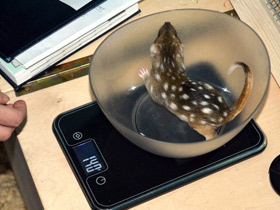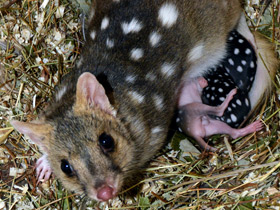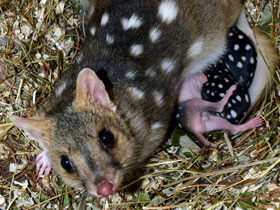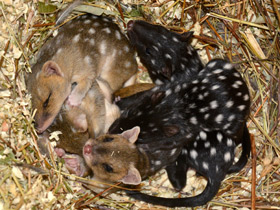The eastern quoll (Dasyurus viverrinus, formerly known as the eastern native cat)
The eastern quoll (Dasyurus viverrinus, formerly known as the eastern native cat) is a medium-sized carnivorous marsupial (dasyurid), and one of six extinct species of quolls. Endemic to Australia, they occur on the island state of Tasmania, but were considered extinct on the mainland after 1963. The species has been reintroduced to fox-proof fenced sanctuaries Victoria in 2003 and to the Australian Capital Territory in 2016.
Taxonomy
The eastern quoll is a member of the family Dasyuridae, which includes most carnivorous marsupials. Its species name, viverrinus, indicates it is "ferret-like". There are no recognised subspecies.
Description and distribution
Dasyurus viverrinus is a species of dasyromorphic marsupial of the family Dasyuridae native to Australia and which has almost completely disappeared from the Australian mainland and has been relegated to Tasmania.
Dasyurus viverrinus is a small cat-sized animal; it is about 45 cm long and weighs about 1.5 kg. Dasyurus viverrinus has a black to yellowish-brown coat colour, with white patches covering its entire body, except for a 30 cm long fluffy tail. It has a beautiful pointed snout and, unlike other species of marsupial sable, it does not have first toes on its hind limbs. Dasyurus viverrinus was once common in south-eastern Australia, but after colonisation it was preyed upon by poultry and rabbits, and ruthlessly consumed by farmers. The introduction of foxes, dogs and cats, the marsupials' food rivals, combined with the epidemics of 1901-1903, also played a role. As a result, Dasyurus viverrinus numbers declined drastically and marsupial martens are now almost extinct on the continent (the last Dasyurus viverrinus was seen in suburban Sydney in the 1960s). Fortunately, the species is still common in Tasmania. However, it is listed as Near Threatened on the IUCN Red List.
Dasyurus viverrinus in zoos and mating habits
To save martens from extinction, it was decided to try captive breeding and housing. This is what zoologists at Leipzig Zoo did. Their work was successful: now the Dasyurus viverrinus breeds there regularly and is doing very well.
A few years ago, the staff of the Moscow Zoo were in Leipzig and liked these cute marsupials so much that they started to find out if the Moscow Zoo could get them. And so, in June 2015, six Dasyurus viverrinus - two males and four females - arrived at Moscow Zoo all at once. After a while, mating was recorded. This process in Dasyurus viverrinus is so unusual that it is hard to ignore.
In nature, it occurs as follows. The female leaves a scent trail behind her, which the male searches for. He stalks her until she lifts her leg and allows him to sniff her thoroughly, indicating that he is ready to mate. During mating, the male jumps on the female's back and clings to her neck. He does this with such vigour that the female's neck swells and a bare patch of skin is left (for Australian colleagues this is a sign of successful mating). Most strikingly, coitus with these marsupials can last up to 24 hours. Sometimes the males are so aggressive in mating that they kill their partner. If a female does not immediately agree to copulate, the male kills her almost immediately. Males, on the other hand, literally exhaust themselves to death trying to produce as many copulations as possible. Throughout the breeding season they fight with competitors, eat little and hardly sleep. As a result, at the end of the year the population of Dasyurus viverrinus may consist only of females and their young.
Reproduction
The gestation length of Dasyurus viverrinus is 20-24 days. Females have a brood pouch that only develops during breeding and opens backwards (otherwise it looks like a fold of skin on the belly). Normally the young are born 5 mm in size and weigh 12.5 mg and climb up the marsupium on their own. Dasyurus viverrinus has 2 colouring stages - there are black and brown Dasyurus viverrinus.
In Moscow Zoo, the female was brown and the male black, so it is not surprising that some of the offspring were black and some were brown. Normally, the female gives birth to between 4 and 8 offspring, although she may have up to 30 embryos. As the actual size of the offspring is limited to only six teats, only the offspring that can reach the pouch first survive.
The young remain in the pouch attached to the teat for about 60-65 days and continue to develop in the burrow until weaning age, which occurs at 150-165 days. Their fur appears at 51-59 days of age; their eyes open at about 79 days; their teeth begin to erupt at 90 days and do not finish until 177 days.
After 8 weeks, Dasyurus viverrinus hatchlings leave the pouch and females take refuge in the den for the duration of the hunt. From 85 days of age, when the young are fully pubescent but still dependent on their mother, they hunt with her at night, often clinging to her back, but gradually their coordination improves and they become increasingly independent.
At around 100 days of age, Dasyurus viverrinus hatchlings are able to kill their prey on their own, before the female helps them to do so.
In nature, mortality of both sexes is very low while they remain with their mother, but is very high during the first 6 months of independent life. Offspring are fully developed and sexually mature by the end of the first year of life. In general, the lifespan of Dasyurus viverrinus is relatively short compared to placental mammals of the same size. Although Dasyurus viverrinus can live up to 7 years in captivity (2 years and 4 months on average), it does not live longer than 3-4 years in the wild.
Habitat and nutrition
In the wild, Dasyurus viverrinus mainly inhabits wet forests in river valleys, but can sometimes be found in gardens and even in the attics of suburban houses (especially in former times). They lead a solitary, nocturnal lifestyle. Spotted martens usually hunt on the ground, but are good at climbing trees. During the day they seek shelter in crevices, rock piles, tree hollows, under roots, abandoned burrows and other secluded places. Their daytime resting place is lined with bark and dry grass.
Dasyurus viverrinus feeds on a wide range of prey: small mammals and birds, lizards and snakes, soil crustaceans, insects and their larvae, earthworms, grass and fruit. Prey size should not exceed 1.5 kg, although Dasyurus viverrinus is quite capable of killing a domestic chicken. As these marsupials have no adaptations for crushing large bones, they can only process the bones of small prey. In the wild, Dasyurus viverrinus often feeds on carcasses of animals killed by Tasmanian devils (the latter are capable of gnawing the carcasses of thick-skinned animals).
Conservation
Tasmania
The eastern quoll likely became extinct on mainland Australia due to predation by introduced predators (red fox) but disease has also been implicated as a potential causative factor of decline. The lack of foxes in Tasmania likely has contributed to the survival of the species there; however, unseasonal weather events and predation by feral cats are thought to have contributed to a possible recent and continuing population declines in Tasmania. The species is currently classified as Endangered by the IUCN.
Mainland Australia
The last eastern quoll specimen on the mainland was collected as roadkill in Nielsen Park, Vaucluse in Sydney on 31 January 1963, however a taxidermied specimen provided to NSW National Parks and Wildlife Service in 2016 was reported to have been collected in 1989 or 1990 in the Gloucester region of NSW, indicating the species may have survived longer than the generally accepted 1960's decade of its mainland extinction. The NSW National Parks and Wildlife service reported numerous unconfirmed sightings and the species was reported photographed as recently as 2013 in the Nungatta district of NSW. Specimens collected in 2005 and 2008 west of Melbourne, Victoria, are likely connected with a nearby wildlife sanctuary, either as direct escapees, or the descendants of escapees from that facility.




















































